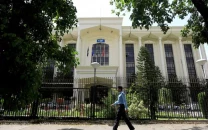Urban infrastructure: The more we take the road less travelled, the higher the price we pay
Karachi’s road building is weak when it comes to drainage and following standards.

Karachi’s road building is weak when it comes to drainage and following standards. SOURCE: INFOVISUAL.INFO/ DESIGN: JAMAL KHURSHID
Shahrah-e-Faisal, which was built about 40 years ago, stands out as a road for its sound construction and durability. It has been least affected by heavy use or the ravages of standing water compared to roads built in the very recent past in Karachi. Why is this so? Why do roads built these days so quickly develop potholes and turn into reservoirs for un-drained rainwater? Why did the administrator of the Karachi Metropolitan Corporation recently feel the need to call a “special meeting” with the director-general of the engineering department and a platoon of chief and executive engineers to discuss the collapse of the CBM/Korangi Causeway and roads in general in the city after these monsoon rains?
There are a number of reasons, often interconnected, why we continue to suffer bad roads. At the top of the list are bad drainage design and infrastructure (and even quite often the complete absence of any drainage at all!) The result, as you know, is that after it rains, or even when there is no rain, water and sewage collects on the roads after sewers and supply lines overflow and leak.
The problem is that the people who build these roads are skimping on some crucial basework. A proper road construction checklist should include ‘earthworks’ for filling - compaction before filling, replacement of unsuitable material - and ‘earthworks’ for drainage - diversions, levees, culverts etc.
Drainage is often not factored in because builders want to bring down costs. Due to kickbacks, rising corruption and mismanagement, costs are also reduced by failing to follow design standards and construction practices, which means that not enough road building material is used, the materials are not mixed properly or compacted. Often, road surfaces start to ‘sag’ adding to the problem. Slopes are not maintained. You will even see that this is happening with roads that form overhead bridges, raising the risk of serious accidents. For example, the NIPA intersection flyover and the flyover at Rashid Minhas Road have sagging pockets where rainwater pools.
Shahrah-e-Faisal, on the contrary, has withstood wear and tear simply because of strict compliance with specifications and standards and because it has a number of strategic drainage outlets. NESPAK gave Shahrah-e-Faisal a major upgrade and extension to what it is today in the early 1980s. It’s not just Shahrah-e-Faisal that has fared so well, other roads in Karachi, such as the MA Jinnah Road and the wide carriageways in Nazimabad, were also soundly constructed.
It certainly doesn’t help that freshly constructed road surfaces are dug up by one civic agency or the other if they need to lay pipes or cables etc. While digging is bad enough, it is worse when no one takes responsibility for re-laying the damaged surface!
It is most unfortunate that a city such as Karachi should have any drainage problems at all since it is well served by a number of natural drainage basins - Lyari and Malir Rivers and their major tributaries (nullahs) e.g. Gujjar and Orangi nullahs. However, these channels and surrounding land have been taken over by squatter settlements or have been blocked by some type of construction or the other. Thus, roads are inundated when access to drainage channels is blocked and they overflow occurs.
Other than faulty construction, design snags are also to blame. Take the case of the CBM Causeway. It is standard practice that when such long distances need to be connected, along a high-flowing water body or riverbed, a causeway is not recommended. Causeways work when distances to be travelled are short and water bodies to be traversed are more like small, low-pressure tributaries. The Malir River basin, when in high flow, packs a substantial hydraulic punch spread over a very large space. Causeways do not provide sufficient grade separation and drainage outlets or piping systems to allow the water to flow beneath. They are not designed to accommodate high pressure and large volumes of water.
It isn’t rocket science to deduce that if the roads are not built properly in the first place, it will cost more to fix the damage eventually.
Farhan Anwar is an urban planner and runs a non-profit organisation based in Karachi city that focuses on urban sustainability. He can be reached at fanwar@sustainableinitiatives.org.pk
Basic materials needed to build a good road
The specifications and standards for the construction of roads and bridges have been laid down by the National Highway Authority (NHA) in Pakistan.
For a typical road, you have the sub-base and the sub-grade on which the road pavement is constructed. In the sub-surface, the foundation is laid and allows for the load to be distributed. The sub-base can also act as a drainage layer. The sub-grade is filled with naturally occurring material, such as sand, silt and clay, and upon which the road pavement is constructed.
In a poorly constructed road, what happens is that a proper mix of material is not prepared. The stones or rocks used do not meet the specifications.
The construction of a road is basically a ‘layering process’. But often fewer layers are laid out to save time and money. The road does not reach the proper level of compactness, which reduces its surface’s ability to bear pressure and it collapses.
On the road pavement, the asphalt or bituminous concrete are at times not thick enough and of sub-standard quality.
The NHA also sets the rates for construction that factor in prices of materials and labour. Average unit rates are calculated for a particular district and not by project. The market can change rapidly.
Published in The Express Tribune, September 9th, 2013.



















COMMENTS
Comments are moderated and generally will be posted if they are on-topic and not abusive.
For more information, please see our Comments FAQ